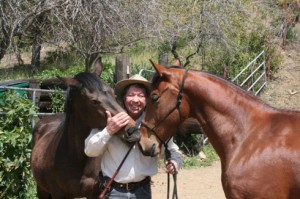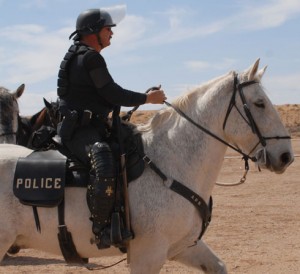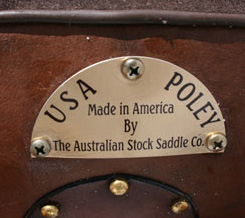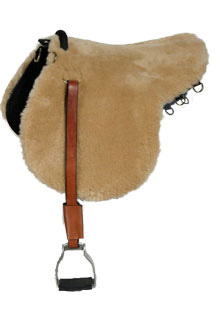Outback Tack
By Talmage Bachman October 12, 2011If you’ve ever been sued by Frank Sinatra for $20 million, spent years traveling the world as a correspondent for news mogul Rupert Murdoch, worked as a Las Vegas entertainer, or spent your formative years rounding up wild cattle in the remotest regions of the Australian outback, your name must be Colin Dangaard.
And we haven’t even gotten to the saddles yet. Since 1982, Australian emigré Dangaard has been making and selling some of the world’s finest saddles from his Australian Stock Saddle Co. in Malibu. Dangaard describes the Aussie as “quite simply, a big dressage saddle. The stirrups hang in a dressage position, and they are free swinging.” I sat down to talk about the art and craft of saddlemaking with the man who arguably has done more than anyone else to popularize the Aussie saddle in North America.
The Equestrian News: You spent your formative years as freelance journalist in Australia, and went on to work in the U.S. at the Miami Herald and then at the Star, when it was still owned by Murdoch. How did you wind up in the saddle business?
Colin Dangaard: I was brought up on a cattle property in Queensland. I made my own saddle when I was a kid because my father wouldn’t buy me one. He said, “Go and make your own,” so I did with the help of another saddle-maker, and I always kept an interest in saddle-making. I then got into journalism, but after years of flying around the world, one day in my house down on the beach in Melbourne I thought, “I’m getting tired of all this, I want to do something different.”
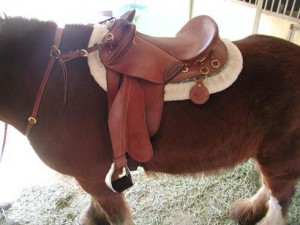
The Australian Poley on a draft horse. The tree construction makes the saddles particularly adaptable to unusually-sized horses, Dangaard says.
So I thought about my biggest accomplishments and I decided it was building that saddle when I was a kid, which I’d sold for quite a bit of money. The Man from Snowy River was being shot in Victoria, down in the Snowy Mountains, at the time. The producers of that asked me to go down and interview Kirk Douglas. So I said, “Yeah, I’ll go down there,” and suddenly I’m looking at one of the daily rushes showing stock saddles, and I said to the director, “What are you going to do with that?” He said, “Oh, we’re going to show it. We’re going to show how Australians really ride.” I was making a ton of money doing what I was doing, but money wasn’t the object. So I thought, “I have a good idea.” I went up to Syd Hill Saddlery knowing that movie’s going to come out, and I plunked down a bunch of money, and bought a whole bunch of saddles.
I had all the saddles shipped to the U.S., and two weeks before The Man From Snowy River came out, I took out full-page ads in horse magazines, saying “Ride like The Man from Snowy River.” And it worked. At one point I was selling a hundred Syd Hill saddles a month.
TEN: So why did you end up making saddles yourself, instead of just continuing to import the Syd Hill saddles
Dangaard: My problem with the Hill saddles was that only fifty per cent of them fit American horses. I was having a huge return rate with them, and the main problem was that the saddle was designed for Australian horses which, by and large, are different shaped. Eighty per cent of horses ridden in America are lower with a more rounded back because of the heavy influence of the quarter horse. So the Syd Hills didn’t work for at least half of the American horses.
TEN: Do you ride
Dangaard: I have three horses right now. I have had as many as 14. I love riding and I’m very passionate about it.
TEN: What kind of riding do you do?
Dangaard: I love natural terrain riding. I’ll saddle up my horse up and ride through the Santa Monica Mountains at 3 a.m. and scare myself to death. I particularly enjoy it if it’s raining and there’s lightning. Most of my friends, their wives have banned them from riding with me. But if the horse is having a good time and I’m having a good time, that’s what it’s all about. The horses want to have fun and be challenged, too. I also do cowboy mounted shooting and mounted archery ― galloping along and shooting arrows like the Huns did. I’m only 69. When I’m 80 I’ll do dressage. (Laughs)
TEN: What you would say to somebody who’s used to riding Western or English about the advantages of an Aussie saddle?
Dangaard: For one thing, of all the saddles in the world, the Australian saddle would be the most versatile. You can chase cattle in it, you can ride a hundred miles in it, pretty much anything.
Aside from the versatility, the advantage of an Aussie saddle is that it’s hard to fall out of, and it’s comfortable to ride. Western saddles were really designed around the idea of roping something and tying it to your saddle. That hasn’t changed much.
So your legs are straight down like this, which is okay for standing and throwing a rope. I did mounted archery, and standing in a Western saddle shooting a bow is really good because you’re platformed. The Huns had the stirrups down the center, too. But unless you’re running around shooting off your horse or throwing a rope, I just don’t see the (advantage) of having your legs straight down like that. If the horse stumbles, boom, you’re going over the top. The Western pommel will half-way save you, but what really saves you with
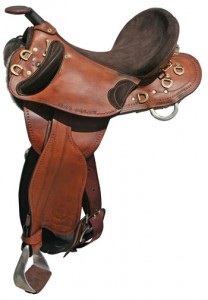
The USA Poley. Poleys are the elliptically-shaped thigh-guards that are a variation on the Western pommel.
the Australian saddle is those knee pads. They grab you.
TEN: The poleys…
Dangaard: Yes, the poleys do a lot of work. Now, English saddles, they’re just pure straight-out self-unloaders. I ride a lot in English saddles when I compete in cross-country, and until recently I did steeplechase. And everything’s fine in an English saddle until something goes wrong. I’ve come out of English saddles dozens and dozens of times. But because of the poleys of an Australian saddle, you can do dangerous, hard, fast riding in it. And you do it safely.
TEN: And the high cantle helps too. Why traditionally no horn on the Australian saddle?
Dangaard: Some customers do want horns, because that’s what they’re used to, so we do offer some models with horns. But a true Australian saddle doesn’t have that because we gather our cattle totally differently. We don’t rope there, we use dogs and whips.
TEN: Your website says “Ask Colin about whips,” so I guess I have to…
Dangaard: I sell a lot of bull whips to people who work stock. It’s funny, when I got to America, I saw people pushing cattle along by waving hats, and I was like, “Hey, why don’t you use a whip?” And it immediately caught on. I’ve done some whips for movies. With my partner, Anthony DeLongis, I designed and delivered the bullwhip that Harrison Ford used in “Indiana Jones.” He wanted a 10-foot whip he could use to take a gun out of somebody’s hand. Whips are an extraordinarily powerful weapon.
I also do a lot of gun leather. I’ve sold hundreds of saddles to U.S. Special Forces in Afghanistan that I designed with custom scabbards to hold their M4 carbine guns. They’re heavy, and if the horse can do that work it’s less wear and tear on the soldiers.
TEN: Your website devotes a lot of space to halters, bridles and bareback pads. How many different items do you make?
Dangaard: Over the years I’ve probably created about 4,000 different items. I’m an inventor. I think all the time about how to improve something. In that I’m incredibly assisted by the people who use my products. I’m absolutely riveted by their opinion, and if three of them say the same thing, I’m back to the drawing board.
TEN: Kind of off-topic, but how did you manage to get sued by Frank Sinatra for $20 million?
Dangaard: Well, his people requested that I interview him when he was in Africa. So I got a tape-recorder, just like yours, and interviewed him. Well, then I write this great story about Frank and the mob and all that stuff and sell it to Rupert Murdoch and so Frank decides he didn’t like it, so he sued me. He claimed that I never interviewed him. We went to the pre-trial here in Los Angeles, and Mickey Rudin, who was his attorney, claimed Frank had never met me. And I said, “Well, here’s a picture of us together, where I’m holding a tape recorder. And here’s a copy of the tape of our conversation.” (Laughs) End of case. Mickey was really ticked off – ticked off with Frank because Frank hadn’t told him!
TEN: Funny! Back to the saddles…Do you design and build them yourself?
Dangaard: I design them, and they’re manufactured in Australia and India, where I ship the Australian leather.
TEN: What sort of trees do you use?
Dangaard: Wood and aluminum. I designed a way to rivet the aluminum rather than weld it. People send me wither tracings and I customize the panels to fit to the horse’s back. Fleece panels are good for horses with a wide, round back. For high-withered horses I use traditional flocked panels.
TEN: You have about 15 different saddles on your website. Which is the most popular?
Dangaard: The Muster Master. It’s made with Australian leather and Australian sheepskin on a wood and aluminum tree. It rides well, it fits well, it’s easy to work with and to manipulate to fit particular horses. Probably the next most popular would be a saddle we call a Fox Poley.
TEN: You’ve been doing this now for a long time. What would you say has been the key to your success?
Dangaard: I want perfection in saddlery. I drive saddle-makers crazy. I literally drive them nuts, because I want what I want, and I put myself in the buyer’s place. I want to do the best for them that I possibly can, really, so I demand perfection.
For more information, visit the Australian Stock Co. website at www.aussiesaddle.com.
Short URL: https://theequestriannews.com/?p=5472



